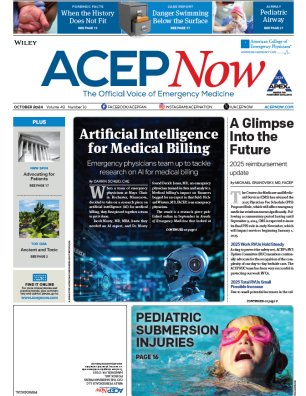It is estimated that anywhere from 72 to 74 million people in the United States aged 20 or older are affected by hypertension.1 This accounts for approximately 30% of the population over 20 years old.2 Somewhere between 3% and 45% of all adult ED patients will have at least one elevated blood pressure reading during their ED stay.3 Given the ubiquitous nature of the predisposing disease, hypertensive emergencies are commonly encountered by emergency physicians. It behooves the emergency physician to be able to readily identify a true hypertensive emergency, and to know when and how elevations in blood pressure should be treated in the emergency department.
Explore This Issue
ACEP News: Vol 31 – No 09 – September 2012Defining the Problem – Is This an Emergency?
In the modern age of pharmaceuticals, with a plethora of antihypertensive agents available to physicians, the incidence of hypertensive emergencies has declined from 7% to 1% of patients with hypertension.4 Still, this presentation is common enough that emergency physicians must be able to readily identify true hypertensive emergencies, and know when and how to treat them.
The classification of hypertension is periodically reviewed by the Joint National Committee (JNC) on Prevention, Detection, Evaluation, and Treatment of High Blood Pressure. The most recent guidelines, the JNC 7 report, were released in 20035 and are currently being updated – the JNC 8 is set for release later this year.
The JNC 7 report does not outline specific blood pressure values in defining hypertensive emergency. Rather, the term “hypertensive crisis” is generally applied when one experiences an acute elevation of blood pressure, with a systolic blood pressure over 180 mm Hg or a diastolic blood pressure over 110.6 Per the JNC 7, a hypertensive emergency is a hypertensive crisis in which there is evidence of acute target-organ damage (e.g., encephalopathy, myocardial infarction, unstable angina, pulmonary edema, stroke, life-threatening arterial bleeding, or aortic dissection). Such cases warrant parenteral drug therapy and hospitalization, often to an intensive care setting.5
Though falling out of favor, the term “hypertensive urgency” is still often used to describe hypertensive crises without evidence of target-organ damage. Such cases usually do not require hospitalization, and can often pose a dilemma for emergency physicians who are uncomfortable sending home patients with persistently elevated blood pressure. Per the JNC 7, cases of “hypertensive urgency” should receive immediate combination oral antihypertensive therapy.5 According to ACEP’s Clinical Policy on Asymptomatic Hypertension in the ED, “initiating treatment for asymptomatic hypertension in the ED is not necessary when patients have follow-up.” If ED treatment is initiated, ACEP’s policy recommends that it should be in an attempt to gradually lower blood pressure and clearly states that blood pressure “should not be expected to be normalized during the initial ED visit.”7




No Responses to “Hypertensive Emergencies”